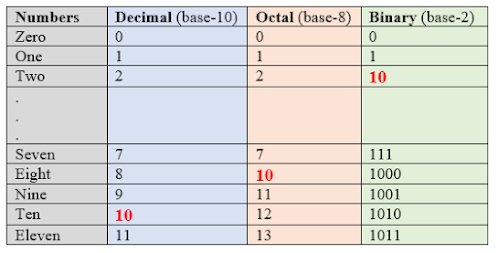Language is often a microscope to social culture, lifestyle, history, and sometimes even prehistoric ages! Today we will see some remnants of the bronze age numeral system found in South- central and South Dravidian languages.
It always was difficult for me to decide on the terms for 90, 900 in Malayalam, the language I learned first. They were the odd ones out of the series; refer Teble1.
 |
| Table 1 |
the suffix(ṇūṟ) forming the number 90 resembles the suffix of the numbers from 100 to 800. Similarly, the suffix of 900 is similar to 1000-8000 pattern. The base form of this odd-pattern is found in the 9-10 pair.
It's not unique to Malayalam but common to the prominent South and South-central Dravidian languages. Over time, some of them have undergone modifications. Examples are cited in table 2. the terms those retained this odd-pattern are highlighted.
 |
| Table 2 |
In Telugu, the term for 9 has an additional 't' sound.
To reveal the mystery, I may have to take you to BCE 3300 - BCE1300, Bronze age. To the Indus Valley Civilization.
Perhaps a few words about numbers and various numeral systems too before that!
We use the decimal numeral system (10 digit system) in general. ie, we have 10 unique symbols; 0- 9. After that, we repeat the same symbols in a new fashion. 10, 11, 12, ..., 19. Then 20, 21,..., 29, etc.
For ease, let's say the decimal system is a base-10 number system.
Computers use a different number system; a binary numeral system that has base-2. It has 0, 1 as unique symbols. then the symbols repeat; 10, 11, 100, 101, 110 etc.
Another is the octal numeral system; a base-8 number system. It has 8 unique symbols.
In table 3, the numbers and corresponding symbols used in decimal, octal, and binary number systems are given. '10' onwards, there are no new symbols.
 |
| Table 3 |
For every individual living on earth, the decimal system may seem the very natural way of counting. We have ten fingers in two hands and we learned to count with those ten fingers in school. We don't lift the leg up in order to show someone we have 11 candies, instead, we simply use hands and additional gesture techniques.
Turns out, there are other interesting ways to count. In the Indus civilization, they used a base-8 number system. Before the invention of 'zero', the counting began from 'one'. So, they counted 1,2,...,8. After number Eight, it was number Ten for the Harappans. In table 4 ( which is constructed primarily following Andronov's and Caldwell's studies, and explanation) [1,2], the proto-Dravidian numbers from one to ten and their possible etymologies are given.
How was the journey from the base- 8 to include a new number nine?
 |
| Table 4 |
How was the journey from the base- 8 to include a new number nine?
The secret lies within the etymology of the term 'tol'.
'tol' has a meaning old or ancient [3], among other variations of it. A classical example is the title 'Tolkāppiyam' meaning 'ancient poem'. It is the oldest work in Tamil literature found to this date.
When the Harappans needed a new number in between Eight and Ten, they called it the old ten == tol+pak-tu.
Later it took various forms.
Oṉbatu (Tamil)
'tol' has a meaning old or ancient [3], among other variations of it. A classical example is the title 'Tolkāppiyam' meaning 'ancient poem'. It is the oldest work in Tamil literature found to this date.
When the Harappans needed a new number in between Eight and Ten, they called it the old ten == tol+pak-tu.
Later it took various forms.
Oṉbatu (Tamil)
Oṉpatu/Oṉbatu (Malayalam)
Ombhattu (Kannada)
Tom'midi (Telugu)
Among the four prominent Dravidian languages, all but Telugu dropped 't'.
Tom'midi (Telugu)
Among the four prominent Dravidian languages, all but Telugu dropped 't'.
Going back to Table 1, Malayalam numerals.
90 is old hundred == thol+nūṟ
900 is old thousand == thol+ āyiraṁ
In nutshell, the odd ones were the remnant of a bronze-age civilization!
Footnote:
Yuki language of California, US (an extinct language) had a base-8 number system. It is suspected that Proto-Indo-Europeans used an octal system too (later 'nine' derived from the term 'newo' meaning new). Perhaps the most natural way of counting was a base-8 number system; using the space between the 10 fingers of our hands.
I am not sure how the invention of Zero (around CE 458) influenced the symbols or how long it took from the invention of 'zero' to the introduction of 'nine' to the number system. There're two symbols found for the number 'Ten' in the Indus numerals. Taking Gundert's analysis on the number 'ten', perhaps Sanskrit- Proto Dravidian mix of symbol and scripts might've happened.